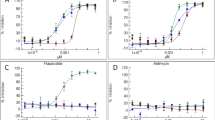Abstract
The southwestern corn borer (SWCB),Diatraea grandiosella Dyar, is a major pest of corn,Zea mays L., in the southern United States. The damage to corn is caused primarily by larval feeding on leaf, ear, and stem tissues. In this study, 2-hydroxy-4,7-dimethoxy-1,4-benzoxazin-3-one (N-O-Me-DIMBOA) was identified by MS and NMR as present in corn whorl surface waxes. This compound has evidently not been isolated previously, but its glucoside has been reported in corn, wheat, andCoix lachryma. It is present in the waxes in a higher concentration than DIMBOA (2,4-dihydroxy-7-methoxy-1,4-benzoxazin-3-one) and 6-MBOA (6-methoxybenzoxazolinone). It was toxic to the SWCB in a stress diet, but it was less toxic to this insect than 6-MBOA when incorporated in the standard rearing diet. Nevertheless, it may have some role in the resistance of corn to the SWCB because the total surface wax content is higher in resistant lines than in susceptible lines.
Similar content being viewed by others
References
Bianchi, G., andAvato, P. 1984. Surface waxes from grain, leaves, and husks of maize.Cereal Chem. 61:45–47.
Campos, F., Atkinson, J., Arnason, J.T., Philogene, B.J.R., Morand, P., Werstiuk, N.H., andTimmins, G. 1989. Toxicokinetics of 2,4-dihydroxy-7-methoxy-1,4-benzoxazin-3-one (DIMBOA) in the European corn borer,Ostrinia nubilalis (Hubner).J. Chem. Ecol. 15:1989–2001.
Chen, C.M., andChen, M.T. 1976. 6-Methoxybenzoxazolinone and triterpenoids from roots ofScoparia dulcis.Phytochemistry 15:1997–1999.
Davis, F.M. 1989. Rearing southwestern com borers and fall armyworms at Mississippi State, MS, pp. 27–36,in J.A. Mihm (ed.) Toward Insect Resistant Maize for the Third World. Proceedings, International Symposium on Methodologies for Developing Host Plant Resistance to Maize Insects, CIMMYT, El Batan, Mexico.
Davis, F.M., Ng, S.S., andWilliams, W.P. 1988a. Mechanisms of resistance in corn to leaf feeding by southwestern corn borer and European corn borer (Lepidoptera: Pyralidae).J. Econ. Entomol. 82:919–922.
Davis, F.M.,Williams, W.P.,Mihm, J.A.,Barry, B.D.,Overman, J.L.,Wiseman, B.R., andRiley, T.J. 1988b. Resistance to multiple lepidopterous species in tropical derived corn germplasm. Mississippi Agricultural and Forestry Experiment Station Technical Bulletin 157, 6 pp.
Davis, F.M., Williams, W.P., andWiseman, B.R. 1989. Methods used to screen maize and to determine mechanisms of resistance to the southwestern corn borer and fall armyworm, pp. 101–108,in J.A. Mihm (ed.). Toward Insect Resistant Maize for the Third World. Proceedings, International Symposium on Methodologies for Developing Host Plant Resistance to Maize Insects, CIMMYT, El Batan, Mexico.
Gambrow, H.J., Luckge, J., Klausener, A., andMüller, E. 1986. Occurrence of 2-(2-hydroxy-4,7-dimethoxy-2H-1,4-benzoxazine-3-one)-β-D-glucopyranoside inTriticum aestivum leaves and its conversion into 6-methoxy-benzoxazolinone.Z. Naturforsch. 41C:684–690.
Hedin, P.A., Davis, F.M., Williams, W.P., andSalin, M.L. 1984. Possible factors of leaffeeding resistance in corn to the southwestern corn borer.J. Agric. Food Chem. 32:262–267.
Hedin, P.A., Williams, W.P., Davis, F.M., andBuckley, P.M. 1990. Roles of amino acids, protein, and fiber in leaf-feeding resistance of corn to the fall armyworm.J. Chem. Ecol. 16:1977–1995.
Hofman, J., andHofmanova, O. 1970. 1,4-Benzoxazine derivatives in plants. A new type of glycoside fromZea mays.Tetrahedron Lett. 3213–3214.
Houseman, J.G., Campos, F., Thie, N.M.R., Philogene, B.J.R., Atkinson, J., Morand, P., andArnason, J.T. 1992. Effect of the maize-derived compounds DIMBOA and MBOA on growth and digestive processes of European corn borer.J. Econ. Entomol. 85:669–674.
Ito, Y., Yokoya, H., Umehara, Y., andMatsuura, T. 1980. Formation of ketone deperoxides from ozonation of o-methyloximes.Bull. Chem. Soc. Jpn. 53:2407–2408.
Klun, J.A., andBrindley, T.A. 1966. Role of 6-Methoxybenzoxazolinone in inbred resistance of host plant (maize) to first brood larvae of European corn borer.J. Econ. Entomol. 59:711–718.
Lyons, P.C., Hipskind, J.D., Wood, K.V., andNicholson, R.L. 1988. Separation and quantification of cyclic hydroxamic acids and related compounds by high-pressure liquid chromatography.J. Agric. Food Chem. 36:57–60.
Nagao, T., Otsuka, H., Kohda, H., Sato, T., andYamasaki, K. 1985. Benzoxazinones fromCoix lachryma Jobi Var. Ma-Yuen.Phytochemistry 24:2959–2962.
Nicollier, G.F., Hedin, P.A., andDavis, F.M. 1982. 5-,6-, and 7-Methoxybenzoxazolinone: Carbon-13 nuclear magnetic resonance spectra and biological activity.J. Agric. Food Chem. 30:1133–1135.
Niemeyer, H.M. 1988. Hydroxamic acids (4-hydroxy-1,4-benzoxazin-3-ones), defence chemicals in the Graminae.Phytochemistry 27:3349–3358.
Ritchie, S.W., andHanway, J.J. 1982. How a corn plant develops. Journal of Iowa State University of Science and Technology Cooperative Extension Service Special Report 48, 21 pp.
Tipton, C.L., Klun, J.A., Husted, R.D., andPierson, M.D. 1967. Cyclic hydroxamic acids and related compounds from maize. Isolation and characterization.Biochemistry 6:2866–2870.
Venis, M.A., andWatson, P.J. 1978. Naturally occurring modifiers of auxin-receptor interaction in corn: Identification as benzoxazolinones.Planta 142:103–107.
Williams, W.P., Buckley, P.M., andDavis, F.M. 1989. Combining ability for resistance in corn to fall armyworm and southwestern corn borer.Crop Sci. 29:913–915.
Wiseman, B.R., Williams, W.P., andDavis, F.M. 1981. Fall armyworm: Resistance mechanisms in selected corn genotypes.J. Econ. Entomol. 74:622–624.
Author information
Authors and Affiliations
Additional information
Mention of a trademark, proprietary product, or vendor does not constitute a guarantee or warranty of the product by the U.S. Department of Agriculture and does not imply its approval to the exclusion of other products or vendors that may also be suitable.
Rights and permissions
About this article
Cite this article
Hedin, P.A., Davis, F.M. & Williams, W.P. 2-hydroxy-4,7-dimethoxy-1,4-benzoxazin-3-one (N-O-Me-DIMBOA), a possible toxic factor in corn to the southwestern corn borer. J Chem Ecol 19, 531–542 (1993). https://doi.org/10.1007/BF00994323
Received:
Accepted:
Issue Date:
DOI: https://doi.org/10.1007/BF00994323




